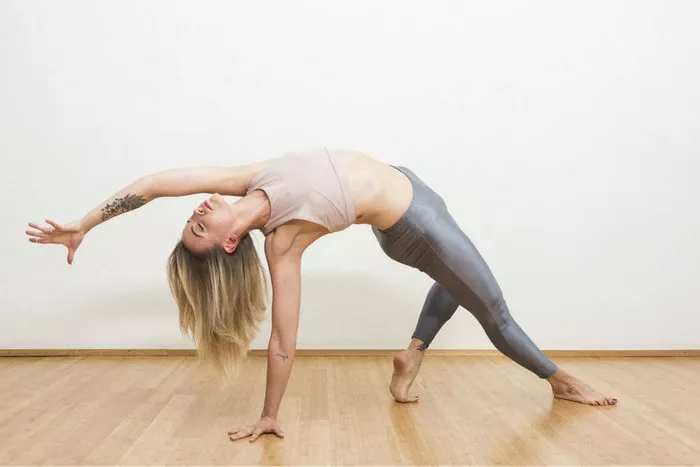Ashtanga yoga is a physically demanding and dynamic form of yoga that follows a structured sequence of postures, synchronized with deep breathing (Ujjayi pranayama) and internal energy locks (bandhas). This practice, known for its intensity and discipline, can provide numerous benefits, such as increased strength, flexibility, mental clarity, and inner peace. However, like any physically rigorous activity, Ashtanga yoga is not without its risks and potential side effects.
While the benefits of Ashtanga yoga are well-documented, it is crucial to understand its possible drawbacks, particularly for beginners or individuals with pre-existing health conditions. This article will explore the side effects of Ashtanga yoga, helping practitioners make informed decisions about their practice.
1. Risk of Injury
Overuse Injuries
Ashtanga yoga involves repeating the same set of poses in a structured sequence six days a week. This repetitive nature can lead to overuse injuries, particularly in joints and muscles that are subjected to continuous stress. Common overuse injuries in Ashtanga practitioners include:
- Shoulder strain (from repeated Chaturangas)
- Wrist pain (from weight-bearing postures like Downward Dog and Arm Balances)
- Knee injuries (from deep hip-opening postures like Lotus Pose)
- Hamstring strain (from excessive forward bends)
Poor Alignment Injuries
Since Ashtanga yoga emphasizes flow and rhythm, practitioners often transition quickly between postures. If proper alignment is not maintained, this can increase the risk of injury. Without adequate guidance, students may push their bodies beyond safe limits, resulting in muscle tears, joint misalignments, and even chronic pain.
Lower Back Pain
Due to the deep forward folds, backbends, and twists in the Ashtanga series, practitioners may experience lower back pain if they lack core strength or flexibility. Overarching the lumbar spine in backbends like Urdhva Dhanurasana (Wheel Pose) can strain the lower back, especially if one’s core engagement is insufficient.
2. Excessive Physical Strain and Fatigue
Ashtanga yoga is demanding and requires a high level of endurance. Regular practice without sufficient rest or recovery can lead to physical exhaustion, muscle soreness, and overall fatigue. Some practitioners push themselves too hard, leading to burnout. Signs of excessive strain include:
- Persistent soreness or stiffness
- Decreased energy levels
- Trouble sleeping due to muscle fatigue
- Weak immune function (frequent colds or infections)
Balancing intense Ashtanga practice with adequate rest and recovery days is crucial to preventing physical exhaustion.
3. Emotional and Psychological Challenges
Frustration and Discouragement
Ashtanga yoga follows a rigid sequence of postures, and students are often required to master one pose before moving on to the next. This structure can be beneficial for discipline but also frustrating for those who struggle with particular postures. Some individuals may feel discouraged if they are unable to progress as quickly as others.
Perfectionism and Mental Stress
Since Ashtanga yoga is deeply rooted in discipline and routine, some practitioners develop an obsession with achieving “perfect” poses or maintaining a strict six-day practice schedule. This pressure can lead to stress, anxiety, and even feelings of inadequacy. Instead of promoting self-acceptance, an overly rigid approach may cause mental strain.
Emotional Releases and Intensity
Yoga, including Ashtanga, can sometimes bring up suppressed emotions. Some practitioners experience unexpected emotional releases during practice, such as sadness, frustration, or even anger. While this can be a positive step toward emotional healing, it can also be overwhelming, particularly for individuals who are unprepared for such experiences.
4. Negative Effects of Heat and Sweating
Ashtanga yoga is often practiced in a warm environment, and the vigorous sequences generate internal heat, leading to excessive sweating. While sweating helps detoxify the body, it can also have drawbacks:
- Dehydration: Losing too much fluid without proper rehydration can lead to dizziness, headaches, and fatigue.
- Electrolyte Imbalance: Sweating excessively without replenishing lost minerals (such as sodium, potassium, and magnesium) may result in muscle cramps and weakness.
- Skin Irritation: Constant sweating can cause rashes, acne, or fungal infections, particularly if one does not shower or change clothes soon after practice.
5. Joint Hypermobility and Instability
Ashtanga yoga requires significant flexibility, particularly in the hips, hamstrings, and shoulders. Some practitioners may push themselves too far in pursuit of deeper stretches, leading to excessive joint laxity or instability. Over time, this can result in chronic pain, joint misalignment, and even conditions like hypermobility syndrome.
To prevent this, practitioners should prioritize stability and strength alongside flexibility, engaging muscles rather than relying solely on passive stretching.
6. Digestive Issues
Ashtanga yoga should ideally be practiced on an empty stomach, but for some individuals, the vigorous movements, deep twists, and abdominal engagement can cause digestive discomfort. Common digestive issues include:
- Acid reflux or heartburn due to deep backbends
- Bloating from excessive abdominal contractions
- Nausea when practicing too soon after eating
To minimize digestive issues, practitioners should allow enough time for digestion before practice and stay hydrated.
7. Hormonal Imbalances (Especially in Women)
Intense physical activity, such as daily Ashtanga yoga, can affect hormone levels, particularly in women. Excessive training without sufficient rest can disrupt the menstrual cycle, leading to irregular periods or even amenorrhea (absence of menstruation). This is often linked to low body fat, stress, and high energy expenditure.
Women practicing Ashtanga regularly should monitor their menstrual health and ensure they are consuming adequate calories to support their physical activity levels.
8. Spiritual and Psychological Overwhelm
Ashtanga yoga is not just a physical practice; it has deep spiritual roots. Some practitioners may find the philosophical aspects, such as devotion (bhakti), breath control (pranayama), and energy locks (bandhas), overwhelming. For those new to yoga philosophy, the traditional aspects of Ashtanga may feel intense or difficult to relate to.
To prevent spiritual burnout, it is helpful to approach the practice with an open mind while focusing on personal growth rather than rigid adherence to traditions.
How to Practice Ashtanga Yoga Safely
To enjoy the benefits of Ashtanga yoga while minimizing the risks, consider the following tips:
- Listen to Your Body – Avoid pushing through pain or discomfort. Modify poses as needed.
- Seek Proper Instruction – Learn from experienced teachers who emphasize alignment and injury prevention.
- Prioritize Rest and Recovery – Balance Ashtanga with restorative yoga, gentle stretching, or rest days.
- Warm Up Properly – Prepare the body with gentle movements before diving into intense sequences.
- Stay Hydrated and Nourished – Drink water and maintain a nutrient-rich diet to support physical exertion.
- Practice Mindfulness – Focus on breath and body awareness to prevent injury and enhance mental well-being.
- Be Patient with Progress – Avoid comparing yourself to others and embrace your unique journey.
Conclusion
Ashtanga yoga is a powerful and transformative practice, but it is essential to approach it with awareness and caution. While it offers incredible physical and mental benefits, its intensity and repetitive nature can lead to injuries, fatigue, and emotional stress if practiced without proper care. By understanding the potential side effects and taking a mindful approach, practitioners can cultivate a sustainable and fulfilling yoga practice.
Yoga is not about perfection or competition—it is about balance, growth, and self-discovery. Whether you are a beginner or an advanced practitioner, practicing Ashtanga yoga safely and wisely will ensure a long-lasting and rewarding experience.
Related Topics:




















